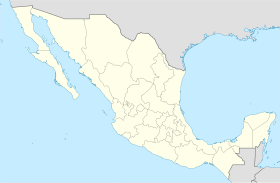San Quintín, Baja California
| San Quintín | |
|---|---|
 |
|
| Location in Mexico | |
| Coordinates: 30°33′37″N 115°56′33″W / 30.56028°N 115.94250°WCoordinates: 30°33′37″N 115°56′33″W / 30.56028°N 115.94250°W | |
| Country |
|
| State | Baja California |
| Municipality | Ensenada |
| Area | |
| • Land | 14,263 sq mi (36,941 km2) |
| Elevation | 92 ft (28 m) |
| Population (2010) | |
| • City | 4,777 |
| • Urban | 4,777 |
| Time zone | Northwest US Pacific (UTC-8) |
| • Summer (DST) | Northwest (UTC-7) |
San Quintín is a coastal town on the west coast of the Mexican state of Baja California, in the municipio of Ensenada, some 190 km (118 mi.) south of the city of Ensenada on Mexican Federal Highway 1. The town is also in the middle of an important agricultural area, especially for growing strawberries and tomatoes. The largest nearby locality is Lázaro Cardenas, home to 16,294 people as of the 2010 census. The whole area (6 localities) houses roughly 25,000 people, up from 20,000 in 2000. This is the largest population cluster south of Ensenada within the state.
The coast also has many sand dunes, and is a popular place for off-road vehicles.
The town is on the west coast of the central Baja California Peninsula, near the Bahía de San Quintín, 300 km (187 mi) south of the San Ysidro–Tijuana international border along Federal Highway 1.
The Misión Santo Domingo de la Frontera lies 20 km north of San Quintín.
San Quintin is home to the largest agricultural company in Baja California.
In the 1880s, a British land company with plans for a wheat empire purchased much of the San Quintín area from the US–based International Land Company; at the time, ILC owned most of northern Baja. In response to promises of agricultural wealth, around a hundred English colonists purchased subdivided land tracts from the parent company, planted wheat, and constructed a gristmill. For flour transportation, the English built a pier on inner Bahiá San Quintín and began constructing a railway to link up with the Southern Pacific tracks to the north in California. Thirty kilometers of track were laid, including a rail causeway from the west bank of inner Bahiá San Quintín, before the colony failed. A 17-ton, six-wheeled locomotive still lies underwater at the mouth of the bay, the remains of a loading accident for the aborted railway.
...
Wikipedia

